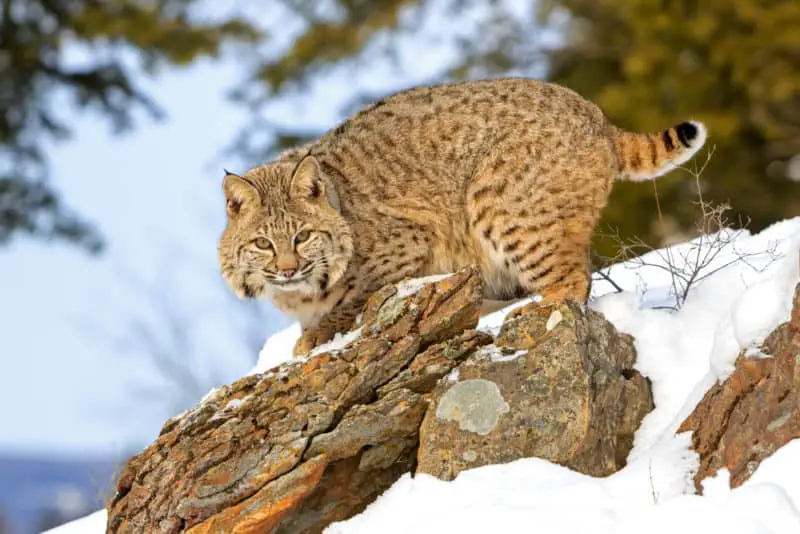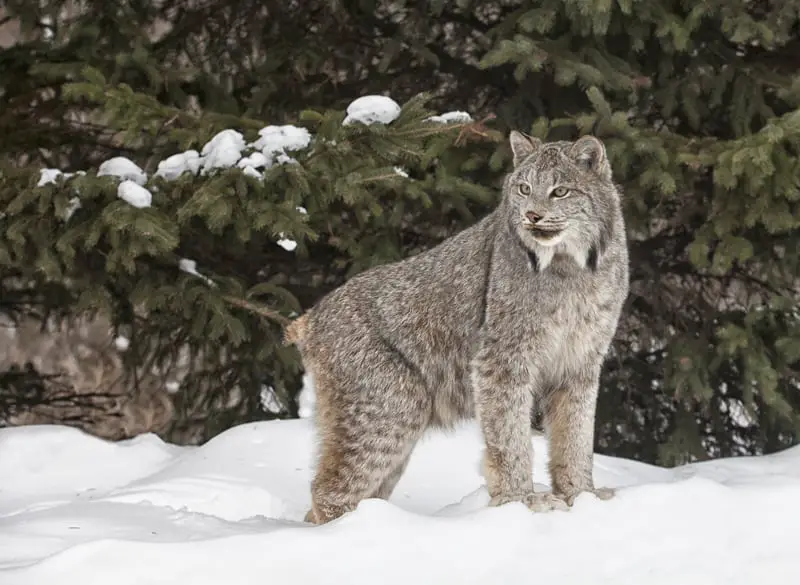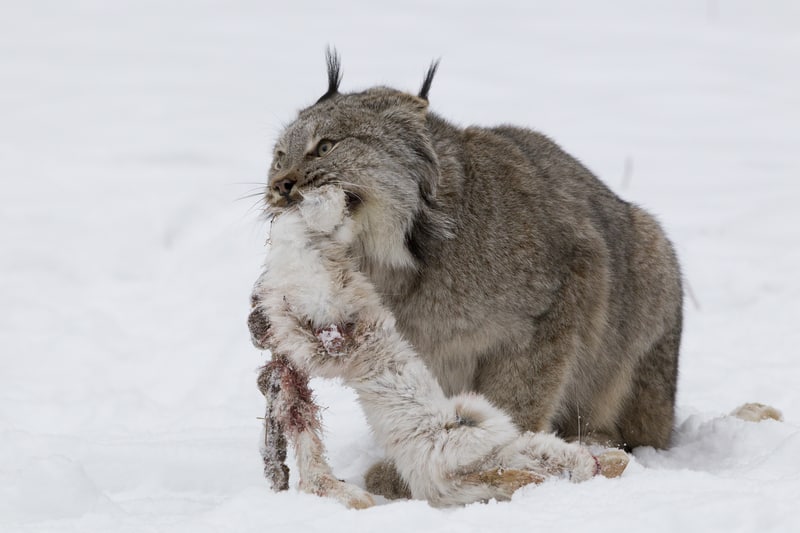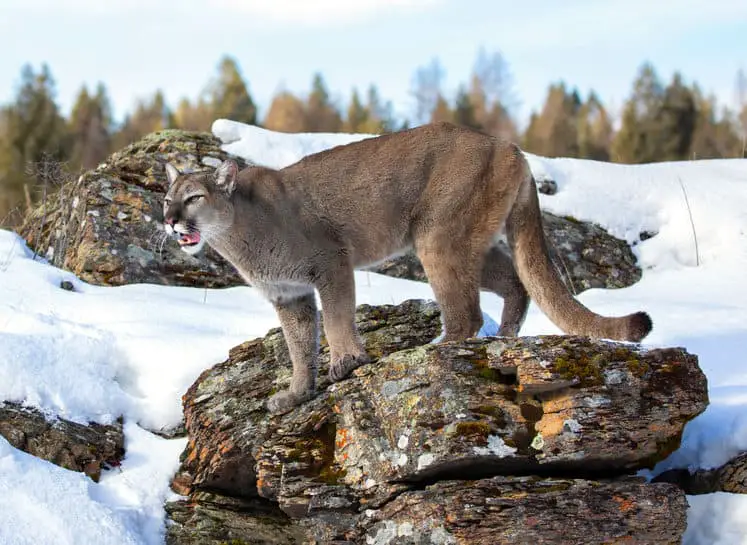According to the Oregon Department of Fish and Wildlife, the state is home to 3 different wildcat species. They all stem from the same family as the common house cat on a larger scale; they are just as lithe and powerful as (Felis catus). They also have retractable claws to hold prey, just as domestic house cats do.
Oregon’s 3 wild cat species are the mountain lion, the bobcat, and the Canada lynx.
Mountain Lions in Oregon (Puma concolor)
In Oregon, the mountain lion, along with black bears and gray wolves, are apex predators. According to the Oregon Fish and Wildlife Department, the state is home to over 6,000 mountain lions.
Where are Mountain Lions Typically Found?
Mountain lions are found throughout the Americas, including parts of all three continents. Consequently, they have many regional names. In 1834, their scientific name was changed from Felis concolor to Puma concolor. Some common names for mountain lions are cougar, catamount, Florida panther, painter, and puma.
In Canada, their biggest populations are in British Columbia and Alberta. On the other hand, in the United States, they mainly live in the western states and Florida in the southeast. In Florida, the cougar is called the Florida panther.
All of Oregon is potentially cougar country. They are distributed throughout western Oregon. However, east of the Cascade Range, cougar populations are mostly concentrated in the Blue Mountains, the Ochoco, and the Wallowa Mountains. Cougar sightings are also on the increase in northwestern Oregon. The 150-mile-long Willamette Valley is home to 75% of Oregon’s human population. It has been the scene of increased mountain lion sightings. Cougars are even seen in the suburbs of Portland on occasion. See
What Do Mountain Lions Look Like?
General Appearance
- A mountain lion resembles a domestic cat with short tan hair and a lean, muscular build.
- Mountain lions are much larger than domestic cats, though. These feline predators are 11 to 26 times larger than a typical house cat.
Body Structure
- Head: Rounded with upright, oval-tipped ears.
- Body: Longish, muscular, feline.
- Tail: Long and muscular. Their proportionately long tail accounts for nearly one-third of their total length.
- A fun fact is that they use their tails as a counterbalance and a rudder. This is handy as they scramble over difficult terrain or make sudden directional changes.
Coat and Coloration
- Primary Color: Light brown, short, and coarse hair covers most of the body.
- Distinctive Markings:
- Black on the area around the nose, ear tips, and tail tip.
- White fur on the belly, upper lip area, lower lip, and chin.
- Dark hair is scattered on their back. This can vary with geographic location.
Size Differences Between Males and Females
- Adult Males:
- Typically, 30–40% larger than females.
- Weigh between 110–180 pounds (50–82 kg), with rare individuals over 200 pounds (91 kg).
- Length: 6–8 feet (1.8–2.4 meters) from nose to tail tip.
- Adult Females:
- Weigh between 80–130 pounds (36–59 kg).
- Length: 5–7 feet (1.5–2.1 meters).
Mountain Lion Comparison with Other Wildcats
- Mountain lions are the fourth largest wildcat in the world.
- They are smaller than the African lion, the tiger, and the jaguar but larger than leopards.
- After the jaguar, they are the second largest wild cat in the Americas.
Unique Characteristics
Their inability to roar, coupled with their ability to purr, distinguishes them from “big cats” like African lions and leopards in the Panthera genus, which can roar but not purr.
Taxonomic Classification:
They are part of the Felis genus due to their inability to roar.
As of 2017, mountain lions are taxonomically divided into two sub-species. The first is (Puma concolor couguar) or northern cougar. Northern cougars range through North America, Central America, and possibly northwestern South America. The second sub-species is (Puma concolor concolor) or southern cougar. These cats range only in South America.
What Do Mountain Lions Eat?
In Oregon, the number of mountain lions is directly correlated to the health of the state’s deer populations. Cougars mainly prey on deer. In fact, on average, an adult mountain lion kills a deer or a deer’s equivalent in biomass once a week. They also prey on other animals.
In Oregon, mountain lions prey on the following animals.
- deer, including mule deer, black-tailed deer, and white-tailed deer
- elk (both Roosevelt and Rocky Mountain)
- moose
- Rocky Mountain and California bighorn sheep
- mountain goats
- pronghorns
- feral horses
- coyotes
- raccoons
- rabbits
- birds
- various small rodents
- American beaver
- porcupines
- skunks
- reptiles and amphibians
- pets and livestock
- Any other native wildlife they can catch.
Mountain Lion Behavior
Mountain lions are solitary animals. It’s a rarity to see two or more together unless during mating or in the case of a female raising young.
They have expansive home territories. In fact, an adult male cougar’s home range is normally more than 100 square miles and up to 250 square miles. They will sometimes mark their territory by leaving claw marks on trees. They also scratch up piles of leaves and or pine needles that they urinate on as a scent marker.
Male mountain lions fight to the death sometimes to defend their territory.
Although they may move around during daylight hours, cougars are crepuscular or nocturnal hunters, preferring to hunt during twilight and dark hours.
Do Mountain Lions Ever Harm Humans?
I’ve taken much of the following section from another one of my blog posts entitled “Are Mountain Lions Dangerous?” Found here.
Fatal mountain lion attacks on humans are extremely rare. There are only 20 records of fatal mountain lion attacks on humans in all of North America in the last 100 years. Don’t let that fact lull you into a complete sense of false security, though. There have been many more mountain lion attacks over the years that didn’t result in a fatality. Mountain lions are, in fact, dangerous.
A mountain lion is a formidably tough wild predatory animal.
- They can sprint at speeds of 40 to 50 miles per hour in short bursts.
- They can leap as far as 40 feet with a running start and jump 15 feet vertically from a flat-footed start. See
- They have a bite force of 750 pounds per square inch. These ninja-like predators typically stalk their prey from behind and then leap on an animal’s back. They then crush their cervical spine or larynx with their powerful jaws.
Here are some recent examples of non-fatal mountain lion attacks on humans. See See
Some Factors That Cause Mountain Lions to Attack Humans
The majority of the time, mountain lions use their ghost-like skills to avoid human contact. On rare occasions, though, they attack humans. Below are a few of the reasons why.
- If the cougar has an injury or some sort of impairment that prevents it from killing its normal prey, it’ll be more likely to look at a person as potential prey.
- Male mountain lions engage in fights for territory. Some of their battles are to the death. A percentage of cougar attacks on humans are perpetrated by hungry semi-juvenile toms that have been kicked out of territories with a more abundant food supply.
- Scientific data suggests that mountain lions that were orphaned at a young age are more likely to attack humans. This is possibly because they missed the part of their training where their mothers taught them that humans are to be feared.
Mountain Lion Hunting in Oregon
The season for Oregon cougars is open year-round. However, it will close when the year’s harvest quota has been met. Hunters are allowed to take one cat per tag. It is illegal to take spotted kittens or any female that is taking care of spotted kittens. See

Oregon’s Bobcats (Lynx rufus)
Quick Facts
- Range: Southern Canada to Southern Mexico, exclusively in North America.
- Size: 15–35 pounds; 2–4 feet long.
- Lifespan: Average 10–12 years in the wild.
- Key Characteristics: Short tail, spotted coat, tufted ears.
Bobcats live only in North America. Their range begins in southern Canada, about where the range of their close relative, the Canada lynx, begins to dwindle out and extends south into southern Mexico.
A bobcat is much smaller than a mountain lion. Bobcats are small wild cats. Bobcats that are a little on the small side are not much bigger than large domestic cats such as Maine Coon Cats.
Physical Characteristics
- A bobcat is 2 to 4 feet long and weighs about 15 to 35 pounds. A Female bobcat is quite a bit smaller than a male.
Appearance:
Ears and Face: Their ears have black tufts of hair at the tips. Their whiskered face seems broader due to their long, ruffled facial hair and whiskers. Their eyes are yellow or green, and they have vertical slit-shaped pupils.
Tail: These animals have a short, “bobbed” tail with a black tip.
Coat: Their fur is usually gray to brown, with dark, mottled black spots on their bodies. They also have black stripes on their inner forelegs and tails.
Body Shape: From a side view, you will notice that a bobcat is slightly higher in the rump than at the shoulders. Bobcats and lynx have long hind legs in proportion to their forelegs.
Like mountain lions, bobcats live a solitary existence most of the time. You’d likely only see two adult bobcats together during the mating season. Female bobcats breed once a year. If they successfully breed, they will have an average of three kittens. After breeding, the male’s role is complete. He goes off to search for more females to mate with. Only the female bobcat cares for the kittens and teaches them how to survive. When they are about a year old, the young bobcats are on their own.
Bobcats are fierce. If you get one cornered, you’ve got a semi-dangerous animal on your hands. It will hiss, growl, and spit like one of the nastiest house cats you’ve ever encountered, only much worse. They mean it, too. They have to be tough and mean to survive.
What Do Bobcats Eat?
Small Mammals: Their main diet consists of smaller animals, particularly:
- Jackrabbits
- Cottontail rabbits
- Snowshoe hares
- Mice
- Squirrels
Additional Prey
- Larger Animals (seasonal or situational):
- They occasionally hunt larger prey, such as small deer. However, they are more apt to pursue deer in the winter when the animals are bogged down in deep, crusted snow.
- Other Prey:
- Reptiles and amphibians
- Birds, carrion, and small pets or domestic animals if near human habitation.
Hunting Behavior
- Bobcats are agile and adaptive hunters.
- Stalking and Ambush: Skilled at stalking and ambushing prey in dense vegetation.
- Quick Reflexes: Known for fast, precise movements, which help when dealing with dangerous prey like rattlesnakes.
Interesting Fact
Even though bobcats are not immune to venom, they successfully hunt rattlesnakes by pinning their heads down and delivering a quick bite to the spine.
Oregon has both Western rattlesnakes and Great Basin rattlesnakes. See
Bobcat Trapping and Hunting in Oregon
See the Oregon furbearer proclamation for information on trapping and hunting bobcats within the state.

Canada Lynx in Oregon (Lynx canadensis)
The Canada Lynx, sometimes also known as the Canadian Lynx, is a medium-sized wild cat that lives in the boreal forest in the high country of Canada and the northern United States. It is one of two North American members of the “Lynx” genus, the other being the bobcat.
Endangered Status
In 2000, the U.S. Fish and Wildlife Service listed the Canada lynx as “threatened” under the Endangered Species Act in the contiguous United States. This classification underscores the species’ vulnerability due to habitat loss and other environmental pressures.
Are There Lynx in Oregon?
Documented sightings of wild lynx in Oregon are exceedingly rare. According to the Oregon Department of Fish and Wildlife (ODFW), it’s unclear whether Canada lynx currently resides in the state. However, if these elusive cats inhabit Oregon, they are most likely found in high-elevation areas such as the Cascade Range, Blue Mountains, or Wallowa Mountains. See
A Personal Lynx Encounter
To this, I’ll add a non-documented Oregon lynx sighting of my own. Around 2008, I was crossing the Blue Mountains at night when a long-legged, bobtailed wild cat with tufted ears crossed the road in front of me. I only got to see the animal while it was within the beam of my headlights, but I’m 99.9% sure it was a lynx. Take that for what it’s worth.
Canada Lynx Characteristics
The Canada lynx is a close relative of the bobcat. The two cats look quite similar. However, there are some distinctions between the two species. Below is a detailed look at their defining characteristics:
- Size:
- Slightly larger than a bobcat, Canadian lynx can reach up to 35.5 inches (90 cm) in length and about 26 inches (65 cm) in height.
- They weigh up to 37.5 pounds (17 kg).
- Ears, Tail, and Facial Features:
- Their ears are triangular with black backs, tipped with long tufts of black hair. These tufts are longer than those of a bobcat.
- Both the Canada lynx and the bobcat have short, black-tipped tails. A bobcat’s tail tip is only black on top, while a lynx’s is black all the way around. While both cats have bobbed tails, a lynx’s tail is shorter than a bobcat’s
- Below their chin, they have a unique, flared white facial ruff.
- Their eyes are green with black pupils that are sub-circular and vertically elongated.
- Body Structure:
- Long legs, with hind legs slightly longer than the front. This gives them a characteristic downhill-sloping appearance.
- Their large, fur-covered paws act as natural snowshoes. This allows them to move efficiently on top of snow. A lynx’s oversized paws can support nearly twice the weight that bobcat feet can on snow. This enables them to thrive in deep snow environments.
- Fur and Seasonal Changes:
- In winter, they have a thick, dense gray coat for warmth and camouflage in snowy landscapes.
- By summer, this coat sheds to reveal shorter, reddish-tan fur.
- A lynx’s coat pattern is more uniform than that of a bobcat. They have a solid tan coloring with occasional darker brown spots on their legs.
Large paws, thick fur, and powerful hind legs enable these wild cats to excel in mountainous and forested habitats.
What Does Canada Lynx Eat?
Mice, squirrels, ptarmigan, grouse, ducks, deer, Dall sheep, and caribou make up a minor portion of a Canadian lynx’s diet in regions where these prey animals are available. However, their preferred food is snowshoe hares, which live in most of their range.

Lynx and Snowshoe Hare
The Canada lynx is very dependent on snowshoe hares as a food source. In some areas, hares comprise 75 percent of their total diet. Their population density is directly correlated with the snowshoe hare population.
Canadian and Alaskan Canadian Lynx and snowshoe hares go through what is known as the Lynx-Snowshoe Hare Cycle. When food sources are abundant for hares, their population increases rapidly since they can have several litters yearly. When hare populations peak, there can be as many as 1500 animals per square kilometer ( 3913 per square mile). At this time, the population of Lynx and other predators are also at their peaks.
In Oregon, Canada, lynx would chiefly depend on snowshoe hares as prey animals. However, they also feed on deer, squirrels, other small mammals, birds, and carrion.
Final Thoughts
Oregon is home to three remarkable wild cat species: the mountain lion, the bobcat, and the Canada lynx. Each plays a vital role in maintaining the balance in the state’s ecosystems.
It is important to understand these animals’ habits, habitats, and challenges. This deepens our appreciation for the natural world. It also underscores the importance of conservation efforts to protect them.
Recent Posts
The only venomous snakes in Washington State are Northern Pacific Rattlesnakes. The Northern Pacific Rattlesnake (Crotalus oreganus oreganus) is a sub-species of the Western Rattlesnake. Anyone...
Skunks are not classified as true hibernators. But they go into a state of torpor when the weather gets cold. Skunks are light sleep hibernators, along with opossums, bears, and raccoons. ...

